Around the World in Many Days, II: Madagascar
Southward bound, we underwent our baptism of fire in the famous --- or infamous --- Madagascan public transport system, the Taxi-Brousse, and we have passed it with colours, perhaps even flying colours.
R S
11 chapters
16 Apr 2020
[Madagascar] Chapter XVI: In which R does not seem to misunderstand in the least what is said to him
September 19, 2017
|
From Antananarivo to Ranomafana, Madagascar, 19-20 September 2017
Southward bound, we underwent our baptism of fire in the famous --- or infamous --- Madagascan public transport system, the Taxi-Brousse, and we have passed it with colours, perhaps even flying colours.

A taxi-brousse is a minibus that runs a fixed long-distance route, regularly loaded with luggage (on the roof) and passengers (under the roof) well beyond the German or Japanese manufacturer's wildest dreams --- or nightmares. Add to this that a taxi-brousse has no fixed timetable --- it leaves when full, which means that an hour of waiting for it to fill is entirely commonplace, and multiple hours not too rare either --- and that a seat is but a virtual commodity --- when you think you have bought one, you find out that you actually share it with one or two other passengers. Furthermore, while the system might appear easily comprehensible to locals, it is anything but to foreigners, as a specific taxi's route and destination are not marked anywhere, nor is it obvious how much it should cost, nor where are tickets to be bought or from whom. This is exacerbated if one wishes to board the taxi anywhere but at its first station, since it may well arrive full there and fail to stop. And the word "station" is used here in the most ethereal meaning of the word, as a taxi will stop to anyone waving by the roadside (unless too full --- except that a taxi-brousse is never really too full --- there is always another place as long as the driver is willing, even if it means someone has to dangle out of a window or an open side door, or sit on top of a friend or a stranger) and practically anywhere requested by a passenger wishing to alight.
As foreigners are not a common sight in taxi-brousse central stations, as soon as we stepped into one, we were surrounded by half a dozen young men, all touts for different taxi-brousse companies, trying to con us (in French, which R speaks) into buying a ticket from them at an outrageously inflated price, swearing to us by all that's holy that that was the formal price, that they were the only official agents, that we had to also buy a return ticket from them and them alone, and that the taxi was just about to leave with only two places left and that we would lose these once-in-a-lifetime seats if we didn't buy them at once. Luckily, we had read a bit about the subject beforehand and were somewhat prepared for the experience, as much as one can be.
An important lesson about Madagascar that we learned on our first day out of Tana was not to make long-term plans. When we set out of Tana, we intended to go only as far as Antsirabe that day, overnight there, and continue south the next day, but having managed to navigate the taxi-brousse system better than we had expected, having reached Antsirabe before noon, having learned that our taxi was actually continuing on to Ambositra, and already occupying the two best seats in the vehicle (the ones next to the driver), we forged onward to Ambositra. Luckily we had not booked a hotel in Antsirabe and decided not to reserve ahead either, trusting ourselves and providence to find lodging anywhere we ended up.
Besides the obvious adavntages of riding a taxi-brousse --- namely the opportunity to feel every bone in your neighbour's body and to be able to inspect every pore in his or her exposed skin ---such a ride also allows one to see the Madagascan landscape firsthand, a landscape that is as beautiful as it is varied. At times we rolled through hilly highlands, some fully forested, some dotted with trees and pocked with boulders, but most so deforested that the soil had collapsed onto itself, uncovering large stony cracks; at times alongside plains and terraces glistening with flooded rice paddies and by enormous ricks of hand-made bricks being burned; at times through field-filled valleys parcelled into tiny plots, each different in shape and size; at times over foggy mountain passes, once crossed revealing deeper valleys and taller mountains in the distance; at times through a tropical rainforest impinging upon the road itself. But most of all we rolled through the main streets of village after village, all strung along the ever-winding road. And where there were villages, there were people, a lot of people, many visibly poor.
Through these scenes our taxi-brousse rolled --- along the narrow mildly-potholed shoulderless road that did allow one car to go in each direction, but not always very comfortably --- sharing the road --- the Route Nationale 7 (RN7), the major highway south --- with all means of terrestrial transport: pedestrians, wheelbarrows, wheelchairs, zebu-drawn carts, rickshaws ("pousse-pousse"), bicycle rickshaws ("cyclo-pousse"), bicycles, motorcycles, tuk-tuks, cars, SUVs, buses, trucks, semi-trailers, and of course many other taxi-brousses, each claiming its own sizeable portion of the very limited road width. Through this obstacle course --- which rarely had a straight stretch of any considerable length in it --- our taxi-brousse rolled, weaving its way left and right at palpably unsafe speeds, honking its horn when needed --- and when not. And only through obscure Malagasy magic as yet unknown to modern science did it fail to hit anything.
And we rolled along, from Antananarivo to Antsirabe to Ambositra on day one, and from Ambositra to Fianarantsoa to Ranomafana on day two, a total of about 500 kilometres in 12 hours, plus three hours of waiting for the taxi-brousses to fill.
But in Madagascar as in Madagascar, one needs to expect the unexpected, which came about on day two, when we reached a bridge that had collapsed only two days earlier, obviously unbeknownst to us, but seemingly also to our fellow passengers and our driver. The solution: all passengers cross the river on foot along the mudbank, while the now lighter taxi-brousse follows a convoluted detour along an improvised non-road, to meet us back a kilometre or so past the bridge, and off we went. But we were the lucky ones, for on both sides of the bridge were parked tens if not hundreds of trucks and buses, too heavy to use the detour, and apparently destined to wait there for days more until the bridge is rebuilt, for there is no alternative to the RN7.
Alas, not many photos, as taxi-brousses are not too prone to stopping along the way at photographically opportune moments.
Accommodations:
- Hotel Mania, Ambositra (1 night; nice)
Photo captions: (a-e) Ambohimanjaka, a small village along the road, where food is sold to passing taxi-brousses; (f-g) the view from Ambohimanjaka; (h) the main street of Ambositra; (i-j) the collapsed bridge

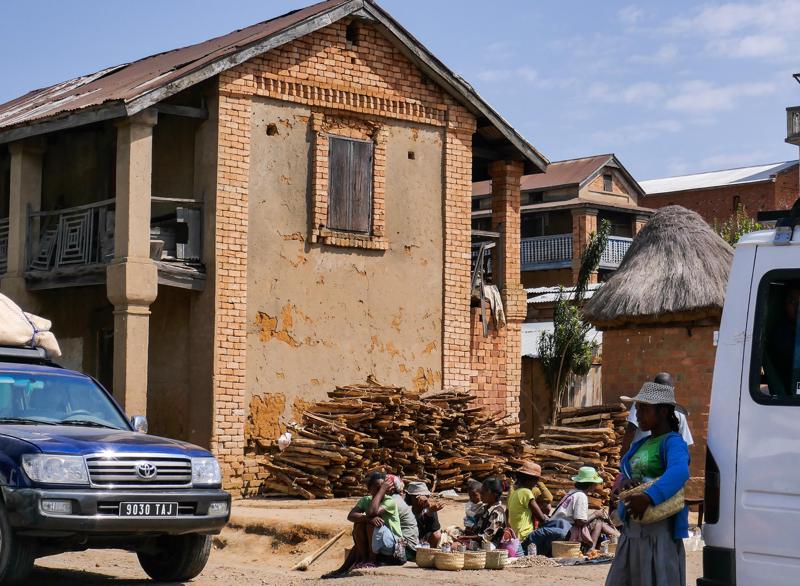
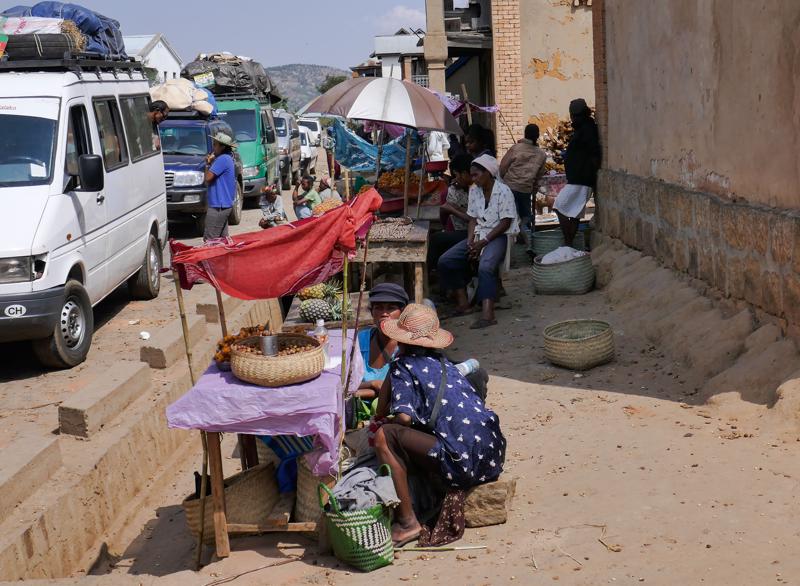




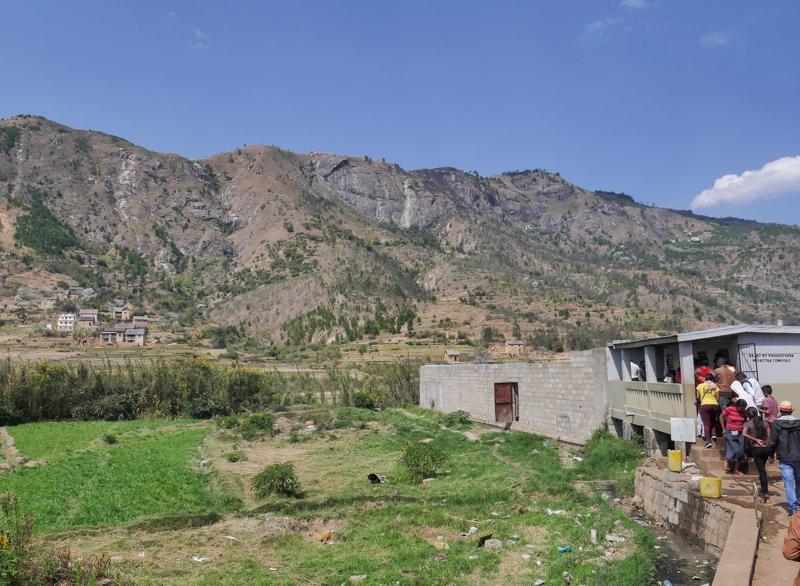
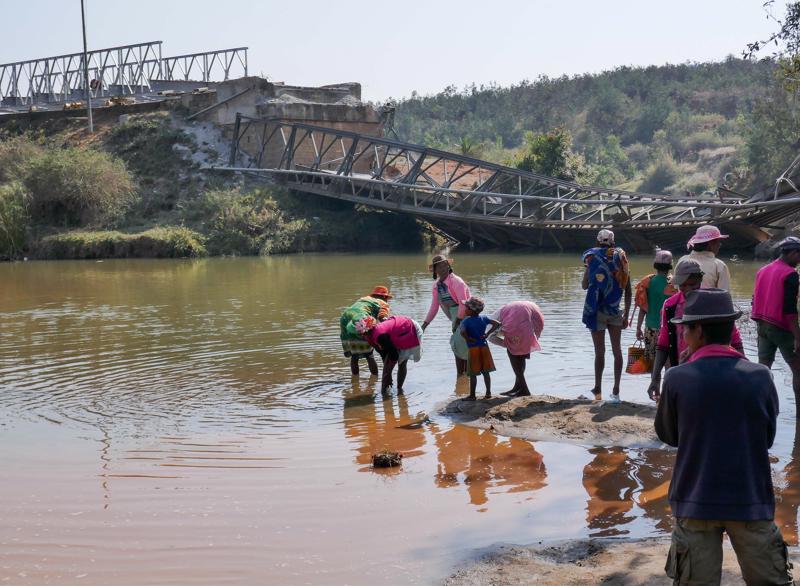
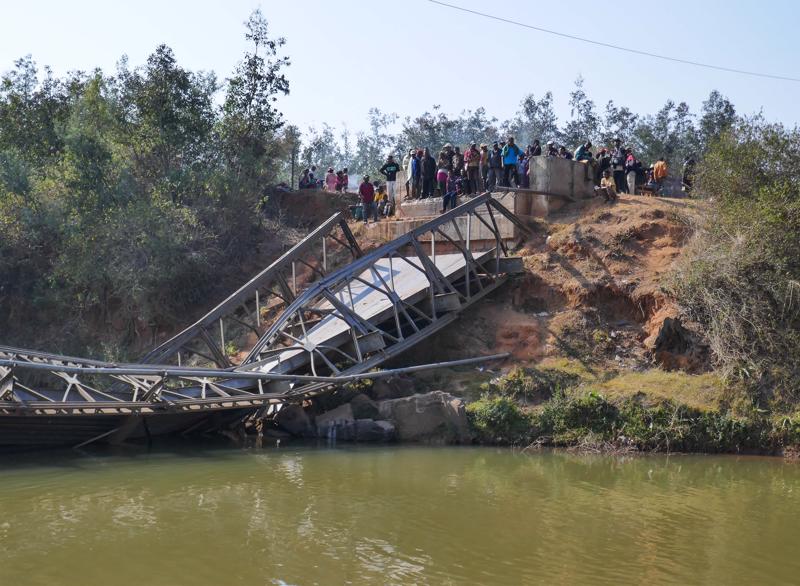
1.
[Madagascar] Chapter XIV: In which we cross the whole of South-East Africa without ever seeing it
2.
[Madagascar] Chapter XV: In which the machine of banknotes disgorges some millions of ariary
3.
[Madagascar] Chapter XVI: In which R does not seem to misunderstand in the least what is said to him
4.
[Madagascar] Chapter XVII: Showing what happened on the voyage from lemur to lemur
5.
[Madagascar] Chapter XVIII: In which a tummy, a taxi-brousse, and a city go each about its business
6.
[Madagascar] Chapter XIX: In which we take a too great interest in water, and what comes of it
7.
[Madagascar] Chapter XX: In which we come face to face with a cliff face
8.
[Madagascar] Chapter XXI: In which the master of the "Kofifi" runs great risk of gaining ariary
9.
[Madagascar] Chapter XXII: In which we find out that, even here, it is convenient to have some money
10.
[Madagascar] Chapter XXIII: In which our pause becomes outrageously long
11.
Summary of Part II and Onwards to Part III
Share your travel adventures like this!
Create your own travel blog in one step
Share with friends and family to follow your journey
Easy set up, no technical knowledge needed and unlimited storage!